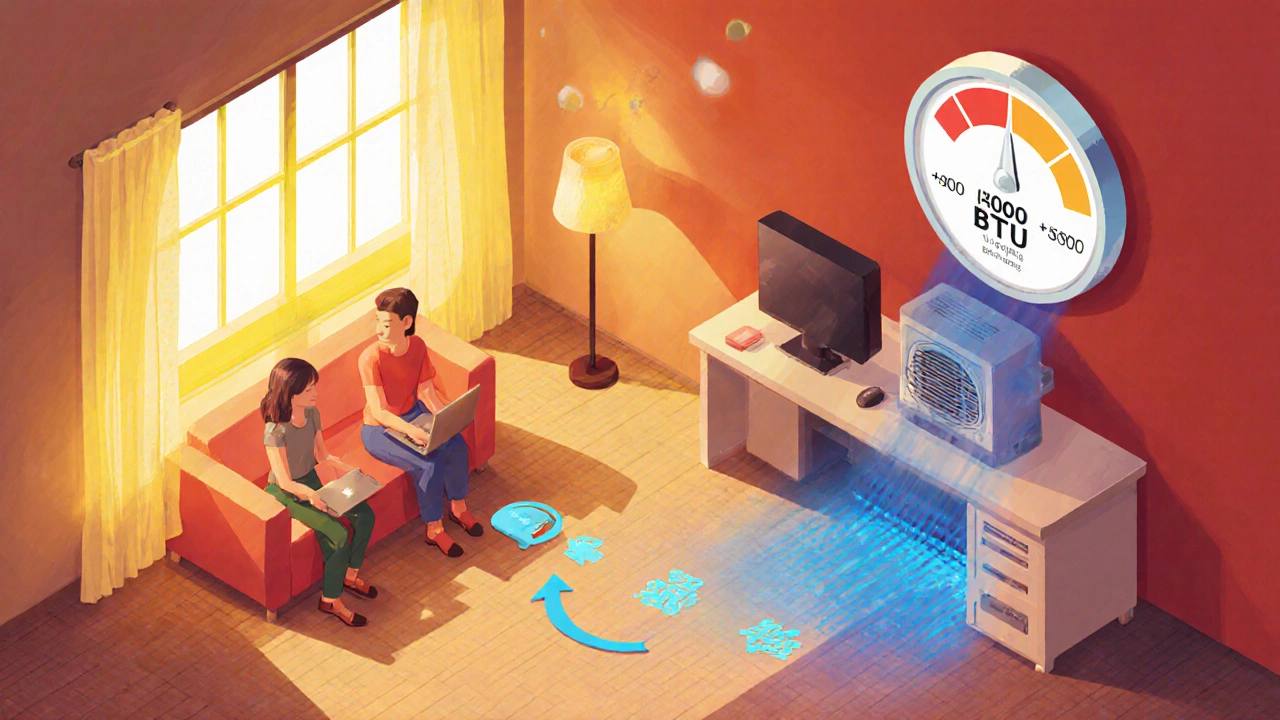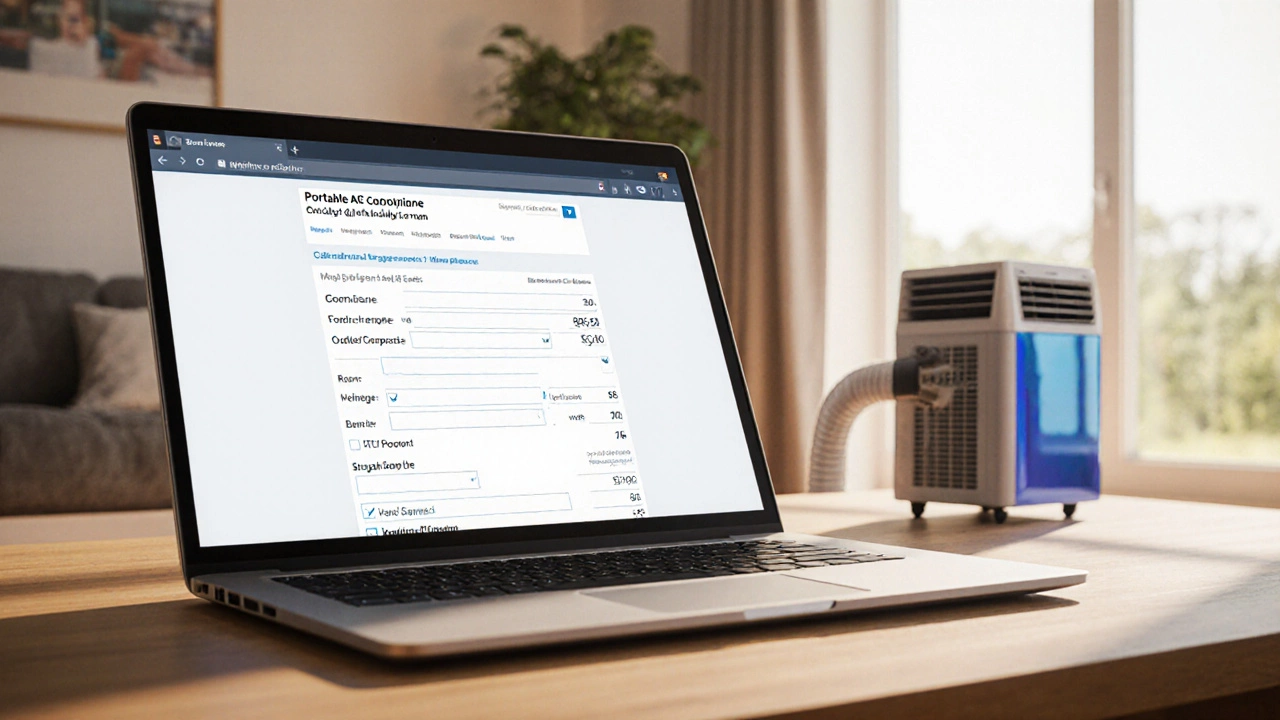Portable AC Runtime Calculator
Input Parameters
Enter details about your space and conditions to estimate daily runtime.
Estimated Runtime
Enter values and click "Calculate" to see estimated runtime
How This Works
This calculator estimates daily runtime based on room size, outdoor temperature, humidity, and AC capacity. It considers factors like:
- Room cooling load (BTU requirement)
- AC efficiency (BTU per watt)
- Environmental conditions (temperature/humidity)
- Insulation quality
Results are approximate and should guide your usage patterns, not serve as exact measurements.
When you buy a portable air conditioner a compact cooling unit designed to be moved from room to room, often used in rentals or small spaces, the first question is usually "how long should it run each day?" The answer isn’t a one‑size‑fits‑all number; it depends on room size, outdoor temperature, humidity, and how you set the thermostat. Below we break down the math, the variables, and the habits that let you stay cool without blowing your electricity bill.
Quick Takeaways
- Typical residential use: 4-8 hours per day for a 10,000BTU unit in a moderate climate.
- Increase runtime during heat spikes or high humidity, but aim to keep the indoor temp around 24°C (75°F) for efficiency.
- Use the built‑in thermostat and auto‑restart features to avoid constant on/off cycling.
- Every extra hour costs roughly $0.12-$0.18 in electricity, based on a 1,200W draw and a 0.13$/kWh rate.
- Regular filter cleaning and proper venting can shave 10-15% off power use.
What Determines the Ideal Run Time?
The core of any cooling calculation is the BTU rating British Thermal Units per hour, a measure of how much heat the unit can remove. A 10,000BTU portable AC can comfortably cool 350-450sqft (32-42m²). If you try to cool a larger space, the unit will run continuously without ever reaching the set temperature, driving up energy use.
Another key metric is the Energy Efficiency Ratio (EER) the ratio of BTU output to watts of power consumed. An EER of 10 means the unit delivers 10BTU for each watt; a higher EER translates to fewer runtime hours for the same cooling load.
Calculating Rough Run Hours
Start with the room’s cooling load: multiply the square footage by a factor of 20BTU per ft² for a sunny room, or 15BTU per ft² for a shaded one. Add 400BTU for each occupant, plus 600BTU for every appliance generating heat (e.g., a computer).
Once you have the total BTU need, compare it to the unit’s rating. If the load is 12,000BTU and your portable AC is rated at 10,000BTU, you’ll need about 1.2×the nominal runtime to maintain comfort. With a typical day‑long demand of 8hours outdoors at 30°C (86°F), a 10,000BTU unit in a 400ft² room usually runs 5-6 hours, cycling on and off as the thermostat hits the set point.
Factors That Stretch or Shrink Runtime
Outdoor temperature - The hotter it is outside, the harder the compressor works, increasing the duty cycle. A 5°C rise can add roughly 15% more runtime.
Humidity - High humidity forces the unit to run the dehumidifying cycle longer. A 10% rise in relative humidity can add 0.5-1 extra hour per day.
Insulation and venting - Gaps around windows or doors let cool air escape. Proper vent hose installation and sealing improve efficiency, often reducing runtime by 10-20%.
Thermostat set point - Each degree you lower the target temperature adds about 10% more runtime. Keeping the thermostat at 24°C (75°F) balances comfort and cost.

Practical Tips to Keep Runtime Low
- Use the unit’s auto‑restart feature that resumes cooling after a power outage instead of manually turning it on and off.
- Place the portable AC near a window, but leave at least 12inches of clearance for the exhaust hose to avoid back‑pressure.
- Close blinds or curtains during peak sun hours - this can cut heat gain by up to 30%.
- Run a ceiling fan in the same room; it circulates cold air and lets the AC shut off earlier.
- Clean or replace the filter usually a reusable mesh that traps dust and improves airflow every month during summer.
Cost Implications of Extra Hours
Most portable ACs draw between 900W and 1,400W when the compressor is active. Using the average 1,200W figure, each hour consumes 1.2kWh. At the Canadian average residential rate of 0.13$/kWh (2025), that’s about $0.16 per hour. Run it 8hours, and you’re looking at $1.28 per day, or roughly $38 per month.
If you can shave two hours off by improving insulation or using a fan, you save about $30 annually. That’s why combining the AC with passive cooling strategies matters as much as the unit’s specs.
When to Adjust the Runtime
During a heat wave (outside temps > 35°C / 95°F), you may need to let the unit run longer, perhaps 8-10 hours, especially if humidity spikes above 70%. In milder weeks (outside temps 20-25°C / 68-77°F), a 3-4 hour window is often enough.
Nighttime cooling can also help. If you set the thermostat to 22°C (72°F) after sunset, the unit may run just 1-2 hours, dropping the indoor temperature enough to stay comfortable until morning.
Comparison of Runtime Scenarios
| Runtime (hours) | kWh used | Cost (CAD) | Typical conditions |
|---|---|---|---|
| 3 | 3.6 | 0.47 | Cool evenings, shaded room |
| 5 | 6.0 | 0.78 | Average summer day, moderate sun |
| 8 | 9.6 | 1.25 | Heat wave, high humidity |
| 10 | 12.0 | 1.56 | Extreme heat, poor insulation |
Frequently Asked Questions
What is the safe maximum daily runtime for a portable AC?
Most units are built to run continuously for up to 12hours, but efficiency drops after 8hours due to heat buildup in the exhaust hose. Aim for 4-8hours unless the space is extremely hot.
Does running a portable AC at night save electricity?
Yes. Nighttime temperatures are lower, so the compressor reaches the set point faster. A 1‑2hour night cycle can reduce daytime runtime by 20‑30%.
How often should I clean the filter to keep runtime low?
At least once a month during heavy use, or whenever the indicator light turns on. A clogged filter can increase power draw by up to 15%.
Can I leave the portable AC on 24hours during summer?
Technically you can, but the unit will cycle constantly, leading to higher electricity costs and faster wear on the compressor. It’s better to use a programmable timer or smart plug.
What’s the difference between BTU and EER when choosing a portable AC?
BTU tells you how much heat the unit can remove; EER tells you how efficiently it does that. For the same BTU rating, pick the model with the higher EER to reduce runtime and cost.
Bottom line: there’s no universal “hours‑per‑day” rule. Base your schedule on room size, outdoor heat, humidity, and the unit’s efficiency. Keep the portable AC runtime in the 4‑8hour sweet spot when conditions are moderate, and use fans, shading, and regular maintenance to shave hours off the bill. With these habits, you stay comfortable, your unit lasts longer, and the electricity meter doesn’t scream.

